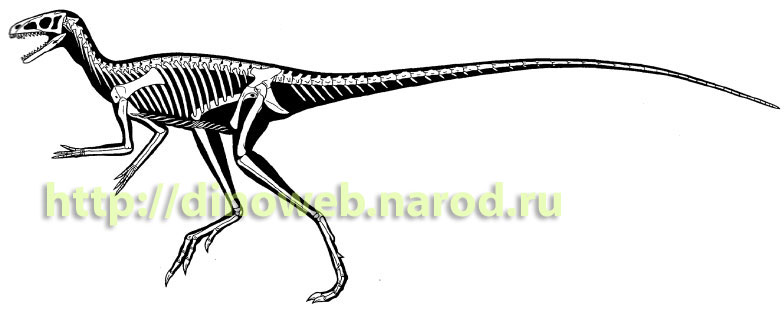
Complete Data Base of Paleozoic and Mesozoic Tetrapods.
Paleo-News and illustrations. Big electronic PDF-library.
| |
| PaleoNews |
| Classification |
| Books and Articles |
| Contact |
| Forum |
сайт о динозаврах
рейтинг сайтов
Free Counter
myspace hit counter
Marasuchus |
Genus: Marasuchus Sereno& Arcucci, 1994 Classification: Archosauria - Dinosauromorpha Etymology: Generic name refers to the mara, or Patagonian cavy (Dolichotis), a solitarily cavimorph rodent that is quite abundant on the plains of the Camp de Talampaya and around the type locality. The mara, which commonly moves with a totting (four-legged, bouncing) gait, closely resembles long-legged rabbits and hares. The name Marasuchus (mara; souchos (Greek), crocodile) thus retains the spirit of Romer’s original genus Lagosuchus (lagos (Creek) Rabbit; souchos (Greek), crocodile). Synonyms: Type species: M. lilloensis (Romer, 1972) Sereno& Arcucci, 1994 Other Species: none Diagnosis: as for species Species: M. lilloensis (Romer, 1972) Sereno& Arcucci, 1994 Etymology: Synonyms: = Lagosuchus lilloensis Romer, 1972 Holotype: PVL 3872: Back of skull, complete left leg except for phalanges, complete right leg, a series of vertebrae including sacrum and caudal vertebrae. Referred Specimens: PVL 4670 Articulated anterior caudal vertebrae lacking chevrons. Time: Ladinian, Middle Triassic. Horizon: Los Chanares Formation. Location: “area de Los Chanares, 2 km al SE de la Puerta de Talampaya.”, more accurately located 3 km north of the north branch of Chanares River and 5 km southwest of the Puerta de Talampaya, Chanares beds, Province of La Rioja, Argentina. Total length: Mass: Diagnosis: Dinosauriform archosaur characterized by anterodorsally projecting posterior cervical neural spines (presacral vertebrae 6-9), marked fossa ventral to the transverse processes in the posterior cervicals and anterior dorsal vertebrae (presacral vertebrae 6 through 10 or 12), subtriangular neural spines in mid- and posterior dorsal vertebrae that contact each other anteriorly and posteriorly, mid-caudal centra twice the length of anterior caudal centra, elongate anterior chevrons that are more than three times the length of the first caudal centrum, broad scapular blade, transversely concave distal pubic blade, and transversely narrow fibular articular surface on calcaneum. Marasuchus lilloensis is a small, carnivorous dinosauriform that is particularly closely related to Dinosauria, sharing with dinosaurs parallelogram-shaped posterior cervical centra, short forelimbs, a partially open acetabulum, an acetabular antitrochanter, a trochanteric shelf on the proximal femur, and a fibular flange on the tibia (Sereno and Arcucci, 1994). Comments:Sereno and Arcucci review the morphology and systematics of Lagosuchus from the Middle Triassic Los Chaiiares Formation. Two species have been named, Lagosuchus talampayensis and L. lilloensis. The holotype of Lagosuchus talampayensis is a fragmentary skeleton that does not exhibit any autapomorphies to distinguish it from contemporary dinosauromorphs, and the genus and species are regarded as nomina dubia. In contrast, the holotype of Lagosuchus lilloensis is a well-preserved skeleton that exhibits several distinctive features, allowing reference of additional specimens. Therefore, designated a new genus, Marasuchus, for the species "Lagosuchus" lilloensis. Holotype of Lagosuchus talampayensis - UPLR 09, fragmentary, semi-articulated postcranial skeleton including the vertebral column from the mid-dorsal to the anterior caudal vertebrae, fragmentary left pectoral girdle and forelimb including the proximal half of the scapula, humerus, radius, and ulna, pelvic girdle and both hind-limbs including the ventral margin of the left ilium, both ischiae and pubes, both femora, partial right and complete left tibiae and fibulae, and left tarsus and pes lacking most of the phalanges. Based solely on its larger size, Romer (1972) named a second species of the genus Lagosuchus, L. lilloensis. The holotype of L. lilloensis (PVL 387 I), however, exhibits several diagnostic characters, which either are not preserved or are at variance with then holotype of Lagosuchus talampayensis. These species, therefore, cannot be synonymized, as suggested by Bonaparte (1975), and we transfer the species L. lilloensis to the new genus Marasuchus. All but one of the specimens previously referred to L. talampayensis can be referred to Marasuchus lilloensis on the basis of the above diagnosis. The one exception is MCZ 4137, a fragmentary specimen preserving the dorsal and sacral vertebral column and a fragmentary pelvis (field number 174, formerly catalogued as MCZ 4116). The neural spines in the dorsal vertebrae of this specimen alternate in shape between subtriangular and rectangular. An alternating pattern in the shape of the neural spines is unknown elsewhere among archosaurs but is quite common among primitive Illustrations: Reconstruction of Marasuchus lilloensis (based on PVL 3870 and 3871). (from Sereno, P. C., and Arcucci A. B., 1994)
References: Romer, A. S., 1971, The Chanares (Argentina) Triassic reptile fauna X. Two new but incompletely known long-limbed pseudosuchians: Brevoria, n. 378, p. 1-10. Romer, A. S., 1972, The Chanares (Argentina) Triassic reptile fauna. XV. Further remains of the thecodonts Lagerpeton and Lagosuchus: Breviora, n. 394, p. 1-7. Sereno, P. C., and Arcucci A. B., 1994, Dinosaurian precursors from the Middle Triassic of Argentina: Marasuchus lilloensis, gen. nov: Journal of Vertebrate Paleontology, v. 14, n. 1, p. 53-73. © Tetrapoda Database Roman Ulansky roman.ulansky@gmail.com or adios85@mail.ru
|

